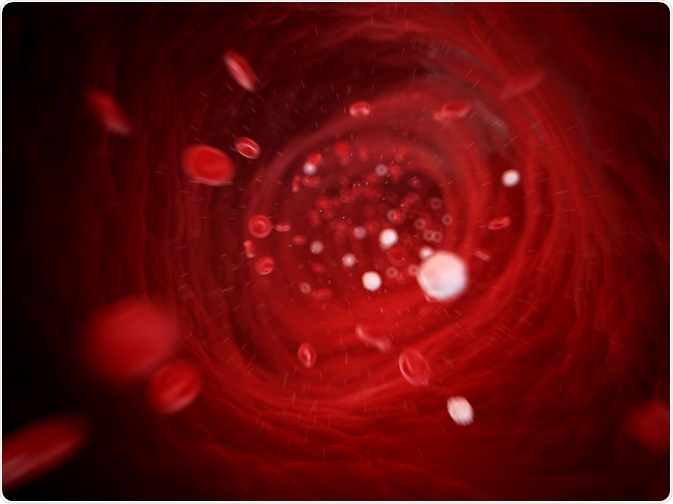The movement of leukocytes from the circulatory system to the site of inflammation and subsequent attachment forms an integral part of the innate immune system. The three steps of leukocyte rolling, activation and adhesion in response to inflammation have been well-documented and studied.
This article will cover:
 Sebastian Kaulitzki | Shutterstock
Sebastian Kaulitzki | Shutterstock
Leukocyte adhesion studies
Rolling, adhesion, and transmigration of leukocytes were initially described by scientists in the nineteenth century. With the discovery of chemokines, chemokine receptors, integrins and selectins, the concept of leukocyte recruitment started to emerge.
Initially, the process was thought to entail three steps: selectin-based rolling of leukocytes, chemokine-based activation, and integrin-based arrest event. However, later studies indicated that the process of integrin-based adhesion was much more complicated than it was previously thought.
While transmigration was reported more than 200 years ago, its mechanism was discovered more recently. With advancements in imaging and genetic tools, an expanded version of the three-step cascade has emerged which now includes slow rolling, strengthening of adhesion, intraluminal crawling, paracellular and transcellular crawling, and basement membrane migration.
What prompts the rolling of leukocytes?
Selectin-mediated rolling
The rolling of leukocytes is mediated by various selectins, most notably L-selectin, P-selectin, and E-selectin. These selectins interact with glycoproteins and other glycosylated ligands. Most leukocytes express L-selectin, but E-selectin and P-selectin are only secreted by inflamed endothelial cells.
P-selectin glycoprotein ligand 1 acts as a ligand for all three selectins, and the binding of P-selectin glycoprotein ligand 1 to L-selectin initiates the leukocyte-leukocyte interaction which involves facilitating the capture and tethering of secondary leukocytes. Secondary tethering also helps leukocytes that do not harbor E-selectin ligands to reach the sites of inflammation.
While P-selectin glycoprotein ligand 1 is present in all leukocytes, it is functional only in cases where the glycosylation is correct. The interaction of selectins with the ligand helps leukocytes in attaching to the inflamed endothelium. Also, shear stress is required for L-selectin and P-selectin to attach.
Integrin-based activation
Integrins are cell surface receptors required for cell-surface molecules (such as G-protein-coupled receptors) to increase their ligand binding capacity. Integrins are also involved in rolling and mediating firm adhesion of leukocytes.
For example, β2-integrins are involved in rolling where engagement by E-selectin causes a conformational change in lymphocyte function-associated antigen 1. This allows it to bind to its ligand, intercellular adhesion molecule 1 (ICAM1). In a study conducted in the human vascular endothelial cell line, the rolling of human lymphocytes was enhanced when ICAM1 was co-expressed with L-selectin ligand.
Extravasation of Neutrophils
The activation and arrest of leukocytes
Several studies performed in vitro and in vivo show that the arrest of leukocytes is triggered by chemokines and chemoattractants; moreover, this process involves the binding of leukocyte integrins to the members of the immunoglobulin superfamily, such as ICAM1 and VCAM2. These are expressed by endothelial cells.
During inflammation, endothelial cells are activated to express adhesion molecules, chemokines, and chemoattractants on their luminal surface. Chemoattractants are also generated by activated mast cells and platelets via proteolytic cleavage, and they are delivered to endothelial cells by circulating microparticles.
These chemokines then bind to glycosaminoglycans on the surface of epithelial cells, and this binding triggers the recruitment of leukocytes. The level of integrin activation also has a role in the regulation of inflammation.
Arrest phase
The specificity of leukocyte arrest is due to the differential expression of integrins, their ligands, and an output of this multi-step process. The variations in the expression levels of chemokine receptors and affinities generate ample diversity in leukocyte recruitment. Modulating the affinity between the integrin and ligand is recognized as an important step to induce arrest under flow conditions.
Transendothelial cell migration
The transmigration of leukocytes into the inflamed tissue represents the final step in this process. Initially, the neutrophils and monocytes crawl inside the blood vessels in ICAM-1 dependent manner, before crossing the postcapillary walls. While crawling, the leukocytes face three kinds of barriers: endothelial cells, pericytes, and endothelial basement membrane.
While migrating through the endothelial-cell barrier can be as fast as two to five minutes, passing through the endothelial cell-basement membrane can take up to five to fifteen minutes. This process can be further complicated by phenotypic differences, endothelial cell-pericytes cell number ratios, as well as by some other factors.
Transmigration can also be initiated by chemoattractants in the luminal space; however, recent studies show that shear stress may also be required for this process. Most leukocytes pass through the endothelial cell junctions, also termed as the paracellular route.
In fact, until recently, this was thought to be the only route of endothelial cell migration. However, subsequent studies show transcellular migration in the central nervous system and in various inflammatory scenarios. In this case, the leukocytes pass through the endothelial cells.
The aforementioned step-like processes of chemoattraction, rolling and adhesion of leukocytes to the wall of the blood vessels, and finally their migration through the endothelial cells to the site of inflammation constitute the innate immune response.
Further Reading
Last Updated: Jul 4, 2019